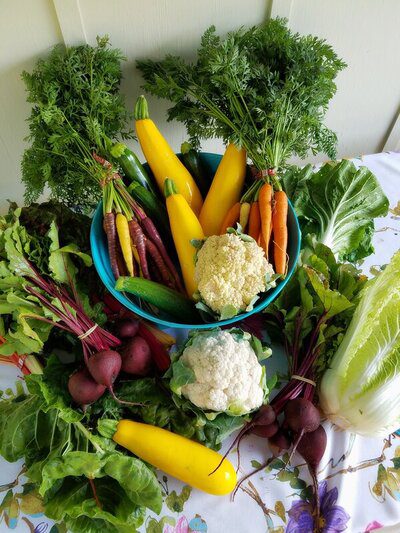Vegetables are an essential part of any healthy diet, but preparing them can be a daunting task. Whether you’re a seasoned chef or a novice in the kitchen, cooking vegetables to perfection can be a bit of a challenge. From roasting to steaming, there are many different techniques you can use to bring out the best in your veggies.
But with so many options available, it can be tough to know where to start. That’s where this guide comes in. In this article, we’ll take a closer look at some of the most effective methods for cooking vegetables, including roasting, steaming, sautéing, and more.
We’ll explore the benefits of each technique, as well as some tips and tricks for getting the best results. So whether you’re looking to up your vegetable game or simply want to prepare more nutritious meals at home, this guide is the perfect place to start.
Nutritional Benefits of Eating Vegetables
Before we dive into the different cooking methods, it’s important to understand the nutritional benefits of eating vegetables. Vegetables are an excellent source of vitamins, minerals, and fibre. They are low in calories and high in nutrients, making them an ideal food for maintaining a healthy weight. Eating a diet rich in vegetables has been linked to a reduced risk of several chronic diseases, including heart disease, diabetes, and certain types of cancer.
Different cooking methods can affect the nutritional value of vegetables. Boiling, for example, can leach out some of the vitamins and minerals, while roasting can help to concentrate the flavours and nutrients. Understanding the different cooking methods can help you choose the best way to prepare your vegetables while maximizing their nutritional value.
Boiling Vegetables
Boiling is perhaps the most common method for cooking vegetables. It involves submerging the vegetables in boiling water and cooking them until they are tender. Boiling is a quick and easy way to cook vegetables, but it can also result in a loss of nutrients.
To minimize nutrient loss when boiling vegetables, it’s important to use a minimal amount of water and avoid overcooking. Overcooking can cause the vegetables to become mushy and lose their flavour. To add flavour to boiled vegetables, try adding herbs, spices, or a squeeze of lemon juice to the cooking water.
Boiling is best for vegetables that are soft and tender, such as broccoli, carrots, and green beans. Harder vegetables, such as potatoes, may take longer to cook and may become mushy if boiled for too long.
Steaming Vegetables
Steaming is another popular method for cooking vegetables. It involves cooking the vegetables in a steamer basket over boiling water. Steaming is a gentle cooking method that helps to preserve the nutrients and flavours of the vegetables.
To steam vegetables, start by filling a pot with a few inches of water and bringing it to a boil. Place the vegetables in a steamer basket and place the basket over the boiling water. Cover the pot and steam the vegetables until they are tender.
Steaming is best for vegetables that are delicate and can easily become mushy when boiled. Vegetables such as asparagus, broccoli, and cauliflower are perfect for steaming. Steaming also works well for leafy greens, such as spinach and kale.
Roasting Vegetables
Roasting is a great way to bring out the natural sweetness and flavours of vegetables. It involves cooking the vegetables in the oven at a high temperature until they are tender and slightly caramelized. Roasting is a versatile cooking method that works well for a wide range of vegetables, including root vegetables, cruciferous vegetables, and even leafy greens.
To roast vegetables, start by preheating the oven to 425°F. Cut the vegetables into bite-sized pieces and toss them with a little olive oil, salt, and pepper. Spread the vegetables out in a single layer on a baking sheet and roast them in the oven until they are tender and slightly browned.
Roasting is best for vegetables that are firm and hearty, such as potatoes, carrots, and Brussels sprouts. It can also be used for softer vegetables, such as zucchini and eggplant.
Grilling Vegetables
Grilling is a popular cooking method that is perfect for summer vegetables. It involves cooking the vegetables over an open flame until they are tender and slightly charred. Grilling adds a smoky flavour to the vegetables and can help to caramelize their natural sugars.
To grill vegetables, start by preheating the grill to medium-high heat. Cut the vegetables into large pieces and toss them with a little olive oil, salt, and pepper. Place the vegetables on the grill and cook them until they are tender and slightly charred.
Grilling is best for vegetables that are firm and can hold their shape on the grill, such as bell peppers, zucchini, and eggplant. Softer vegetables, such as tomatoes and mushrooms, may become too mushy on the grill.
Sautéing Vegetables
Sautéing is a quick and easy cooking method that involves cooking vegetables in a little bit of oil over high heat. Sautéing works well for vegetables that are tender and cook quickly, such as onions, mushrooms, and bell peppers.
To sauté vegetables, start by heating a little bit of oil in a large skillet over high heat. Add the vegetables to the skillet and cook them, stirring frequently, until they are tender and slightly browned.
Sautéing is best for vegetables that are tender and cook quickly, such as mushrooms, onions, and peppers. Harder vegetables, such as carrots and broccoli, may take longer to cook and may not be suitable for sautéing.
Related: Green bean and Walnut salad
Best Vegetables to Cook with Each Method
Each cooking method works best for different types of vegetables. Here are some examples of the best vegetables to cook with each method:
– Boiling: broccoli, carrots, green beans
– Steaming: asparagus, broccoli, cauliflower, leafy greens
– Roasting: potatoes, carrots, Brussels sprouts, zucchini, eggplant
– Grilling: bell peppers, zucchini, eggplant
– Sautéing: mushrooms, onions, peppers
Tips for Cooking Vegetables to Perfection
No matter which cooking method you choose, there are some tips and tricks that can help you cook your vegetables to perfection:
– Cut the vegetables into uniform pieces to ensure even cooking.
– Use a minimal amount of oil to prevent the vegetables from becoming greasy.
– Don’t overcrowd the pan or baking sheet, as this can prevent the vegetables from cooking evenly.
– Season the vegetables with spices, herbs, or a squeeze of lemon juice to add flavour.
– Cook the vegetables until they are tender but still have a slight crunch.
Conclusion
Cooking vegetables to perfection can be a challenge, but with the right techniques, it’s easy to bring out the best in your veggies. Try experimenting with different cooking methods to find the ones that work best for your favourite vegetables. Whether you’re roasting, steaming, sautéing, or grilling, there are plenty of ways to enjoy the nutritional benefits and delicious flavours of fresh vegetables.

